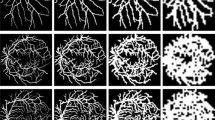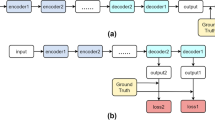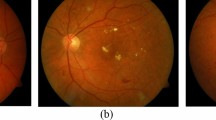Abstract
Retinal hemorrhage detection is of great significance for clinical diagnosis and disease control. However, most of the traditional methods need to obtain candidate lesions firstly, and then determine the true lesions. To address this problem, we propose an end-to-end multi-scale gated network (MGNet) to directly detect hemorrhage. Taken the U-Net as the backbone, we first add a skip connection gated module (SGate) to the skip connection to suppress useless information. Secondly, we propose a high-resolution and low-resolution multi-scale fusion module (HLMS) to improve the representation capacity of network through fusing information from the adjacent decoder layers. Furtherly, we propose a weighted Dice loss (W-Dice loss) to focus on the hard samples. Extensive experiments on two publicly available datasets: DIARETDB1 and IDRiD, demonstrate that the proposed MGNet achieves competitive results of hemorrhage detection compared with the state-of-the-art works.















Similar content being viewed by others
Explore related subjects
Discover the latest articles, news and stories from top researchers in related subjects.References
Cheung N, Mitchell P, Wong TY (2010) Diabetic retinopathy. Lancet 376(9735):124–36
Hatanaka Y, Nakagawa T, Hayashi Y, Kakogawa M, Sawada A, Kawase K, Hara T, Fujita H (2008) Improvement of automatic hemorrhages detection methods using brightness correction on fundus images. In: Proceedings of SPIE, vol 6915, pp 69153E–1
Xiao ZT, Zhao BF, Zhang F, Geng L, Wu J, Wang W, et al. (2015) Hemorrhages detection in fundus image based on k-means clustering and adaptive template matching. Chin J Biomed Eng 34 (3):264–271
Sirajudeen A, Ezhilarasi M, Multi-scale LBP (2015) SVM classifification to identify diabetic retinopathy in lesions. Curr Med Imag Rev 11(1):527–538
Caramihale T, Dan P, Ichim L (2016) Detection of regions of interest in retinal images using artifificial neural networks and K-means clustering. In: IEEE. ICECOM: 22nd International Conference on Applied Electromagnetics and Communications; 2016 Sep 19-21; Dubrovnik, CROATIA. IEEE, 345 E 47TH ST, New York, pp 1–6
Yang Y, Shang F, Wu B et al (2020) Robust Collaborative Learning of Patch-level and Image-level Annotations for Diabetic Retinopathy Grading from Fundus Image[J]
Xie Y, Zhang J, Lu H et al (2020) SESV: Accurate Medical Image Segmentation by Predicting and Correcting Errors[J]. IEEE Trans Med Imaging PP(99)
Yang Y, Li T, Li W, Wu H, Fan W, Zhang W (2017) Lesion detection and grading of diabetic retinopathy via two-stages deep convolutional neural networks. In: MICCAI. Springer, pp 533–540
Dong N, Gao Y, Li W et al (2018) ASDNet: Attention Based Semi-supervised Deep Networks for Medical Image Segmentation[C]// International Conference on Medical Image Computing and Computer-Assisted Intervention. Springer, Cham
Ronneberger O, Fischer P, Brox T (2015) U-net: Convolutional networks for biomedical image segmentation. In: Navab N, Hornegger J, Wells WM, Frangi AF (eds) Medical image computing and computer-assisted intervention-MICCAI 2015. Springer International Publishing, Cham, pp 234–241
Shelhamer E, Long J, Darrell T (2017) Fully convolutional networks for semantic segmentation. IEEE Trans Pattern Anal Mach Intell 39(4):640–651
Lin T-Y, Dollar P, Girshick R, He K, Hariharan B, Belongie S (2017) Feature pyramid networks for object detection. In: Proceedings of IEEE Conf. Comput. Vis. Pattern Recognit. (CVPR), pp 936–944
Takikawa T, Acuna D, Jampani V et al (2019) Gated-SCNN: Gated Shape CNNs for Semantic Segmentation[J]
Shivaram JM, Patil R, aravind HS (2009) Automated detection and quantification of haemorrhages in diabetic retinopathy images using image arithmetic and mathematical morphology methods. International Journal of Recent Trends in Engineering (IJRTE), vol 2, pp l74–176
Jaafar HF, Nandi AK, Al-Nuaimy W (2011) Automated detection of red lesions from digital colour fundus photographs. Conference proceedings:. Annual International Conference of the IEEE Engineering in Medicine and Biology Society. IEEE Engineering in Medicine and Biology Society. Conference, pp 6232–6235
Bae JP, Kim KG, Kang HC, Jeong CB, Park KH, Hwang JM (2011) A study on hemorrhage detection using hybrid method in fundus images. J Digit Imaging 24(3):394
Gao WW, Shen JX, Wang YL, Liang C, Zuo J (2013) Algorithm of locally adaptive region growing based on multi-template matching applied to automated detection of hemorrhages, Spectrosc. Spect Anal 33 (2):448–453
Jwu B, Sza B, Zxa B et al (2019) Hemorrhage detection in fundus image based on 2D Gaussian fitting and human visual characteristics - ScienceDirect[J]. Opt Laser Technol 110:69–77
Kande GB, Savithri TS, Subbaiah PV, Tagore M (2009) Detection of red lesions in digital fundus images. In: IEEE International Symposium on Biomedical Imaging From Nano to Macro, 2009. ISBI’09. IEEE, pp 558–561
Seoud L, Hurtut T, Chelbi J, Cheriet F, Langlois JMP (2016) Red lesion detection using dynamic shape features for diabetic retinopathy screening. IEEE Trans Med Imaging 35(4):1116–1126
Pradhan S, Balasubramanian S, Chandrasekaran V (2008) An integrated approach using automatic seed generation and hybrid classifification for the detection of red lesions in digital fundus images. In: IEEE 8th International Conference on Computer and Information Technology Workshops, 2008. CIT Workshops 2008. IEEE, pp 462–467
Zhang X, Chutatape O (2005) A SVM approach for detection of hemorrhages in background diabetic retinopathy[C]// IEEE International Joint Conference On Neural Networks, 2005. IJCNN ’05. Proceedings, IEEE
Sreeja KA, Kumar SS (2021) Pradeep a automated detection of retinal hemorrhage based on supervised classifiers and implementation in Hardware[M]
Gulshan V, Peng L, Coram M, Stumpe M, Wu D, Narayanaswamy A, Venugopalan S, Widner K, Madams T, Cuadros J, Kim R, Raman R, Nelson P, Mega J, Webster D (2016) Development and validation of a deep learning algorithm for detection of diabetic retinopathy in retinal fundus photographs. JAMA 316(22):2402–2410
Szegedy C, Vanhoucke V, Ioffe S, Shlens J, Wojna Z (2016) Proceedings of the IEEE Conference on Computer Vision and Pattern Recognition (CVPR), pp 2818–2826
Haloi M (2015) Improved Microaneurysm Detection using Deep Neural Networks. Computer Science
Orlando JI et al (2017) Learning to Detect Red Lesions in Fundus Photographs: An Ensemble Approach based on Deep Learning
Grinsven MV, Ginneken BV, Hoyng C, et al. (2016) Fast convolutional neural network training using selective data sampling: Application to hemorrhage detection in color fundus Images[J] IEEE Trans Med Imaging, pp 1273–1284
Cheriet PC (2018) A multitask learning architecture for simultaneous segmentation of bright and red lesions in fundus images. international conference on medical image computing and Computer-Assisted intervention. Springer, Cham
Milletari F, Navab N, Ahmadi SA (2016) V-Net: Fully convolutional neural networks for volumetric medical image Segmentation[C]// 2016 fourth international conference on 3D vision (3DV). IEEE
Xia H, Liao Y, Song S et al (2021) Microaneurysm detection in fundus images based on a novel end-to-end convolutional neural network[J]. Biocybernet Biomed Eng 41(2)
Kauppi T et al (2007) The DIARETDB1 diabetic retinopathy database and evaluation protocol. Tech Rep
Idrid diabetic retinopathy segmentation challenge. https://idrid.grand-challenge.org/. 7
Niemeijer M, Ginneken BV, Staal J, Suttorp-Schulton MS, Abramoff MD (May 2005) Automatic detection of red lesionsin digital color fundus photograph. IEEE Trans Med Imaging 24(5)
Saito T, Rehmsmeier M (2015) The precision-recall plot is more informative than the ROC plot when evaluating binary classififiers on imbalanced datasets. PloS One 10(3):e0118432
Ye L, Zhu W, Feng S et al (2020) GANet: Group attention network for diabetic retinopathy image segmentation[C]// Image Processing
Xiao Q, Zou J, Yang M et al (2020) Improving Lesion Segmentation for Diabetic Retinopathy using Adversarial Learning[J]
Porwal P, Pachade S, Kokare M et al (2019) IDRid: Diabetic Retinopathy-Segmentation and Grading Challenge[J]. Med Image Anal 59:101561
Gondal WM, Kohler JM, Grzeszick R, et al. (2017) Weakly-supervised localization of diabetic retinopathy lesions in retinal fundus images[J]. IEEE
Quellec G, Charriere K, Boudi Y et al (2016) Deep image mining for diabetic retinopathy screening[J]
Lei Z, Li P, Qi Y et al (2016) Automatic hemorrhage detection in color fundus images based on gradual removal of vascular branches[C]// 2016 IEEE International Conference on Image Processing (ICIP). IEEE
Junior SB, Welfer D (2013) Automatic detection of microaneurysms and hemorrhages in color eye fundus images. International Journal of Computer Science Information Technology (IJCSIT), vol 5
Kauppi T et al (2007) The DIARETDB1 diabetic retinopathy database and evaluation protocol. Tech Rep
Sambyal N, et al. (2020) Modified U-Net architecture for semantic segmentation of diabetic retinopathy images. Biocybernet Biomed Eng 40:3
Zhou Z, Siddiquee MMR, tajbakhsh N et al (2018) UNet++: A Nested U-Net Architecture for Medical Image Segmentation[J]
Oktay O, Schlemper J, folgoc LL et al (2018) Attention U-Net: Learning Where to Look for the Pancreas[J]
Gu Z et al (2019) CE-Net: Context Encoder Network for 2D Medical Image Segmentation. IEEE Trans Med Imaging:1–1
Guo S et al (2019) Random Drop loss for tiny object segmentation: Application to lesion segmentation in fundus images. International conference on artificial neural networks. Springer, Cham
Acknowledgements
This work was supported in part by the National Natural Science Foundation of China under Grant 61762014 and 62106054, and in part by the Science and Technology Project of Guangxi under Grant 2018GXNSFAA281351.
Author information
Authors and Affiliations
Corresponding author
Additional information
Publisher’s note
Springer Nature remains neutral with regard to jurisdictional claims in published maps and institutional affiliations.
Rights and permissions
About this article
Cite this article
Xia, H., Rao, Z. & Zhou, Z. A multi-scale gated network for retinal hemorrhage detection. Appl Intell 53, 5259–5273 (2023). https://doi.org/10.1007/s10489-022-03476-6
Accepted:
Published:
Issue Date:
DOI: https://doi.org/10.1007/s10489-022-03476-6




